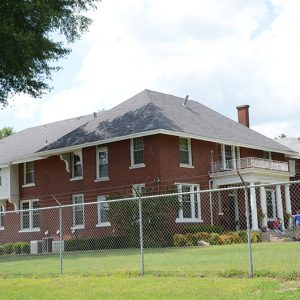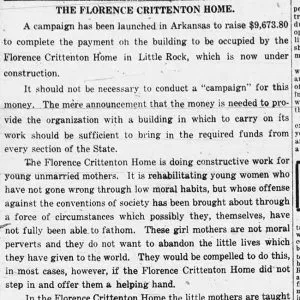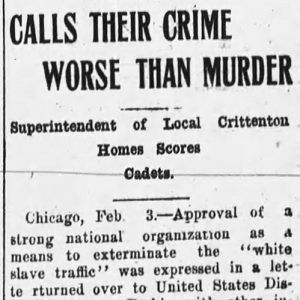calsfoundation@cals.org
Florence Crittenton Home
Established in 1903, the Little Rock Florence Crittenton Home (LRFCH) operated as a rehabilitative and reform institution for unwed mothers. The LRFCH’s building was listed on the National Register of Historic Places on December 22, 1982.
In 1883, wealthy evangelist Charles N. Crittenton founded the first Florence Crittenton Home (FCH), which was named after his daughter. Located in New York City, it was a rescue mission for prostitutes. In the early 1900s, the FCH sought to increase its clientele by refocusing its reform efforts on unmarried pregnant women.
In October 1903, at the invitation of local ministers, Charles Crittenton visited Little Rock (Pulaski County) and held a series of revival meetings in the city’s churches. Shortly after his visit, civic activists formed a board of directors for the future LRFCH. The board included author Bernie Babcock and Laura Stafford Remmel, who was the wife of state Republican Party leader Harmon L. Remmel. Opening in December 1903, the LRFCH had its first clients by early 1904. As part of “reforming” themselves, clients agreed to mother their children. They studied the Bible and learned how to sew, cook, clean, garden, and perform nursing duties in preparation for reentering society.
The FCH’s association with prostitution drew hostility from some local residents. During a 1910 Little Rock city council discussion concerning funding for the Humane Society, which provided child and animal welfare services at that time, Mayor William R. Duley attacked the LRFCH and its staff’s anti-prostitution activities. Speaking to the press prior to the city council meeting, the Board of Trade Secretary favored funding the society and identified Humane Society Officer W. M. Rankin as the source of a claim that Little Rock had 100 starving child residents—a claim that Rankin expressed in a letter to Laura Remmel. Duley vetoed a resolution designed to place the humane officer on the regular police force and accused Rankin of trying to “malign [the] city.” Denying that prostitution was a problem locally, Duley charged that the LRFCH had “not accomplished a single result.”
On March 29, 1916, a fire of undetermined origin destroyed the LRFCH’s new building, which was unoccupied but opening soon. The Reverend Hay Watson Smith, a member of the LRFCH’s board of trustees, suspected foul play. In a sermon, Smith attributed the fire to arson motivated by ignorance of the home’s purpose. Although a $500 reward was offered for information leading to a conviction, the case remained unsolved.
Set to rebuild by late 1916, the LRFCH originally chose former governor George Washington Donaghey, a trustee, to draft the building plans. Unlike Duley in 1910, Mayor Charles E. Taylor praised the home’s “splendid charitable work” and indicated that local builders were willing to donate labor for the rebuilding. Designed by the architectural firm of Charles L. Thompson, the LRFCH’s new Colonial Revival–style brick building opened on April 24, 1918. Added in 1928, the Pollock Memorial Nursery was named in honor of longtime president Elizabeth Pollock.
Following the lead of the national FCH after World War II, the LRFCH promoted adoption instead of mothering. In the 1940s and 1950s, white women who were single and pregnant were diagnosed as mentally ill and deemed unfit to be mothers; they were told, however, that they could achieve rehabilitation by relinquishing their babies to a thriving adoption market. By the 1950s, the LRFCH was also offering their clients high school classes.
Racist views of African Americans as naturally licentious and promiscuous meant that pregnancy in single black women usually, but not always, drew little attention from the organizers of homes for unwed mothers. In 1949, however, white LRFCH administrators and black community leaders established a separate FCH for African Americans. In July 1949, the organizers purchased, with funds mostly raised from African Americans, a home for the new FCH, which was located in Sweet Home (Pulaski County). (One source indicated that former lieutenant governor Calvin Comins Bliss formerly owned the property.) In operation until the early 1960s, the African-American FCH offered the same services as the white home.
In the 1960s and 1970s, fully legalized birth control and abortion changed women’s reproductive options, although the LRFCH served 234 women in 1967. In 1973, the home began offering confidential pregnancy testing.
In 1982, the LRFCH building received National Register certification because of its historical function and association with Charles L. Thompson’s architecture.
In the 1980s, the LRFCH offered clients a choice of whether to place their infants for adoption. In 1983, Arkansas first lady Hillary Rodham Clinton spoke at one of the home’s eightieth anniversary celebration events.
Free Will Baptist Family Ministries began operating the LRFCH in 2004 as a residential group home to provide emergency shelter or long-term residential care for abused and neglected young people, pregnant teens, and mothers and babies. In 2025, the city of Little Rock undertook plans to purchase the LRFCH for use as a homeless shelter.
For additional information:
“Crittenton Home.” Arkansas Democrat, November 8, 1903, p. 5.
“Crittenton Home Fired.” Arkansas Gazette, June 26, 1916, pp. 1, 10.
“Crittenton Home Observance Today.” Arkansas Gazette, April 23, 1933, p. 4.
“Crittenton Negro Home Purchased.” Arkansas Democrat, July 3, 1949, p. 8.
“Duley’s Veto Sustained.” Arkansas Gazette, July 12, 1910, p. 1.
“Events Mark Home’s 80th Anniversary.” Arkansas Democrat, May 2, 1983, p. 13.
“FCH Services.” Arkansas Democrat, February 25, 1973, p. 38.
“Florence Crittenton Home.” National Register of Historic Places registration form. On file at Arkansas Historic Preservation Program, Little Rock, Arkansas. Online at http://www.arkansaspreservation.com/National-Register-Listings/PDF/PU3165.nr.pdf (accessed April 6, 2021).
Free Will Baptist Family Ministries—Florence Crittenton Home of Little Rock. http://www.fwbfm.com/arkansas-ministries/florence-crittenton-home/ (accessed April 6, 2021).
Kunzel, Regina. Fallen Women, Problem Girls: Unmarried Mothers and the Professionalization of Social Work. New Haven: Yale University Press, 1993.
“Long Fight Cornerstone of New Crittenton Home.” Arkansas Democrat, October 7, 1951, p. 8.
“Open House.” Arkansas Democrat, April 4, 1968, p. 18.
“Plan to Rebuild Crittenton Home.” Arkansas Gazette, May 8, 1916, p. 3.
“Rebuild Burned Crittenton Home.” Arkansas Gazette, December 28, 1916, p. 12.
Solinger, Rickie. Wake Up Little Susie: Single Pregnancy and Race Before Roe v. Wade. New York: Routledge, 1994.
“Starving Babes in Little Rock.” Arkansas Democrat, July 6, 1910, p. 7.
Melanie K. Welch
Mayflower, Arkansas
 Early Twentieth Century, 1901 through 1940
Early Twentieth Century, 1901 through 1940 Historic Preservation
Historic Preservation Florence Crittenton Home
Florence Crittenton Home  Crittenton Home Funding Editorial
Crittenton Home Funding Editorial  Florence Crittenton Home Story
Florence Crittenton Home Story  White Slavery Story
White Slavery Story 



I was in this home in 1977. They definitely did not encourage you to keep your child. As a matter of fact, it was the complete opposite. We were pressured to place the children for adoption. The place was segregated. Downstairs gave the impression that everything was elegant and lovely. Not so upstairs where we were housed. After delivery, we were placed in a separate section of the building and kept isolated for ten days. Wasn’t an ideal situation.
Excellent history; courageous women.